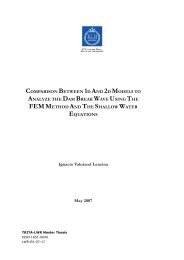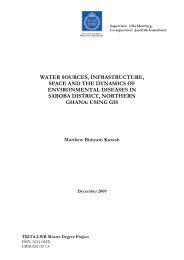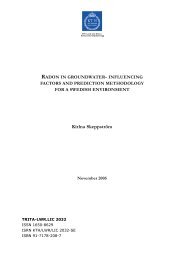POTENTIAL BIOGAS PRODUCTION FROM FISH WASTE AND ...
POTENTIAL BIOGAS PRODUCTION FROM FISH WASTE AND ...
POTENTIAL BIOGAS PRODUCTION FROM FISH WASTE AND ...
Create successful ePaper yourself
Turn your PDF publications into a flip-book with our unique Google optimized e-Paper software.
Potential Biogas Production from Fish Waste and Sludge2.3. BMPThe BMP test is a conventional laboratory-scale method to measure CH 4production and evaluate the efficiency of AD process and the biodegradabilityof feedstock. The CH 4 is produced from the degradablesubstrates mixed with inoculums based on the certain proportion underthe anaerobic condition. Nowadays, the BMP test is widely used in theco-digestion analysis, which can optimize the whole process by reducingthe influence of inhibited factors on the co-digestion process in the labscaleas much as possible. For example, It can determine the optimalHRT and C:N ratio so as to obtain the maximum methane gas. Theoptimal outcomes could be the reference of the full-scale digestionprocess (Esposito et al, 2012).The conventional BMP test process is to incubate a number of sealedbottles including the required analyzed proportion of substrates andinoculums at the controlled temperature, and manually measure thebiogas yield by manometric or volumetric method and biogascomposition by gas chromatography at fixed periods (Esposito et al,2012). However, the conventional BMP test needs expensive laboratoryinstruments such as gas chromatography, and very time and laborconsuming, as well as could not obtain sufficient and high quality data.As to disadvantages of the conventional BMP test, the BioprocessControl Sweden Company worked out the new instrument for theanalysis of AD, called AMPTS. This instrument follows the basicprinciple of the conventional BMP test, but it strips CO 2 and other acidgas in the biogas by using NaOH solution before measuring the volumeof CH 4. The volume of pure CH 4 production can be detected on-line byusing liquid displacement & buoyancy method directly, even extreme lowflow. The AMPTS not only provides a higher quality and adequatequantity of data but also uses less labor and inexpensive equipment. Itpresents an understandable dynamic degradation profile. Therefore, inthis research, the AMPTS II was used for the analysis of potential biogasproduction under the different proportion of co-digestion.2.4. Pre-studyAs it was mentioned in the project description (1.2 section), this projectwas a continuation of the study on potential biogas production from fishwaste and by-catch. Before this project start, two pre-studies had alreadyfinished by Almkvist and Tomczak-Wandzel which built solidfoundations for this project.The pre-conditions planned for the pre-studies were similar. Firstly, theused fish waste and by-catch were extracted from cod and pike by thefishing industry in the Simrishamn. Moreover, the instrument was usedfor conducting both studies were AMTPS II. Furthermore, the wholeexperiment was conducted in the mesophilic condition (37 ± 0.5 ºC)with stirring every one minute.However, several decisions, such as the types of supplementarysubstrates, the cultivation of inoculums, and the ratio between substrateand inoculums, plus the proportion of the composition of varioussubstrates, were made differently in each study according to its ownpurpose (Table 2).In the Almkvist’s study (2012), the possibility of CH 4 production fromfish offal and by-catch was investigated. Grass and primary & secondarysludge from the Hammarby Sjöstadsverk WWTP were mixed with fishoffal and by-catch in six different proportions due to their low content9
















